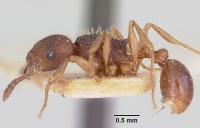Tetramorium steinheili
| Tetramorium steinheili | |
|---|---|

| |
| Scientific classification | |
| Kingdom: | Animalia |
| Phylum: | Arthropoda |
| Class: | Insecta |
| Order: | Hymenoptera |
| Family: | Formicidae |
| Subfamily: | Myrmicinae |
| Tribe: | Crematogastrini |
| Genus: | Tetramorium |
| Species: | T. steinheili |
| Binomial name | |
| Tetramorium steinheili Forel, 1892 | |
Tetramorium steinheili is a very common species in many montane rainforests of eastern Madagascar. The altitudinal range they occupy lies from 500 to 1700 m, although it is usually found above 1000 m, and most specimens were collected from leaf litter.
Identification
A member of the Tetramorium dysalum-species group
Hita Garcia and Fisher (2012) - Tetramorium steinheili can be best recognised within its species group by the following character combination: short antennal scapes (SI 71 - 76); eyes small to moderate (OI 21 - 23); propodeal spines long to very long (PSLI 27 - 44); propodeal lobes variably long, but never long and spinose; petiolar node squamiform with anterodorsal margin situated slightly higher than posterodorsal margin, dorsum tapering backwards posteriorly; dorsum of mesosoma with longitudinally arranged rugae; hairs on first gastral tergite erect or suberect.
This species displays extraordinary intraspecific variation. While the general body habitus remains very stable, there is remarkable variation in the length and shape of the propodeal spines and the propodeal lobes. The spines are long in all examined material, but they differ in length from one population to another while they are comparatively constant on a local scale. The same is true for the spine shape, since it can vary in thickness and acuteness. Generally, many series from the centre of the distribution range have shorter spines than seen in those from further north or south, although some central series also have very long spines. The propodeal lobes are also fairly variable since they differ from broadly triangular and comparatively short to elongate triangular and comparatively long, and they can be acute or blunted. This variation is relatively stable within populations, and represents a remarkable intraspecific variation since this character is generally highly constant in most Malagasy Tetramorium. Furthermore, some series of T. steinheili, especially from the southeast, have smooth or almost smooth mandibles, whereas most other populations have distinctly striate mandibles. Another interesting variation concerns the sculpture on the petiolar node. It is mostly unsculptured with few rugulae laterally and posteriorly, and generally has a very shiny look. Specimens from Ambohitantely however, have a fine reticulate-punctate to punctate ground sculpture laterally and posteriorly, which gives the node a rough appearance. Also, the colouration can vary from one series to another. Generally, most specimens possess a reddish brown colour with yellowish brown appendages, although there are some series in which the appendages are of the same colour as the remaining body, and other series are darker brown or yellowish brown without any reddish tone.
Keys including this Species
Distribution
Madagascar. The southernmost known locality is Andohahela and the northernmost Bemanevika, but it is also known from Analavelona in the southwest. Interestingly, the distribution is somewhat disjunct since T. steinheili is fairly common in a strip from Andohahela in the south to Ankazobe, Andranomay, and Betampona but is very rare further north, and the next localities are Anjanaharibe and Bemanevika. Together with T. dysalum it has certainly the broadest distribution range within the group, although T. dysalum also occurs in the north of Madagascar and Nosy Be. (Hita Garcia and Fisher 2012)
Latitudinal Distribution Pattern
Latitudinal Range: -14.75° to -24.91666667°.
| North Temperate |
North Subtropical |
Tropical | South Subtropical |
South Temperate |
- Source: AntMaps
Distribution based on Regional Taxon Lists
Malagasy Region: Madagascar (type locality).
Distribution based on AntMaps
Distribution based on AntWeb specimens
Check data from AntWeb
Countries Occupied
| Number of countries occupied by this species based on AntWiki Regional Taxon Lists. In general, fewer countries occupied indicates a narrower range, while more countries indicates a more widespread species. |

|
Estimated Abundance
| Relative abundance based on number of AntMaps records per species (this species within the purple bar). Fewer records (to the left) indicates a less abundant/encountered species while more records (to the right) indicates more abundant/encountered species. |

|
Biology
Castes
Worker
Images from AntWeb
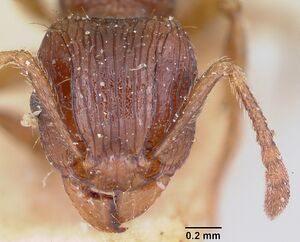 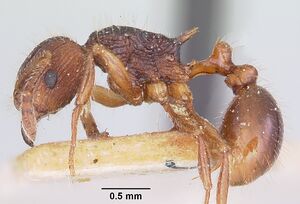  
| |
| Paralectotype of Tetramorium steinheili. Worker. Specimen code casent0101258. Photographer April Nobile, uploaded by California Academy of Sciences. | Owned by MHNG, Geneva, Switzerland. |
  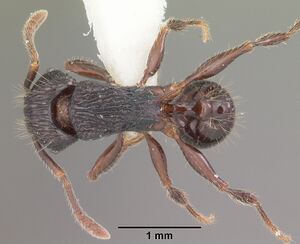 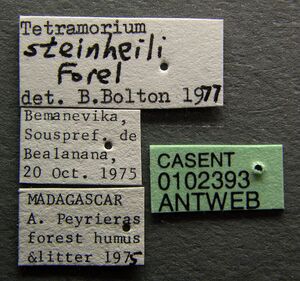
| |
| Worker. Specimen code casent0102393. Photographer April Nobile, uploaded by California Academy of Sciences. | Owned by NHMUK, London, UK. |
  
| |
| Worker. Specimen code casent0102394. Photographer April Nobile, uploaded by California Academy of Sciences. | Owned by NHMUK, London, UK. |
   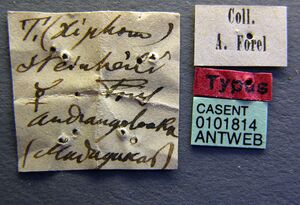
| |
| Lectotype of Tetramorium steinheili. Worker. Specimen code casent0101814. Photographer Nick Olgeirson, uploaded by California Academy of Sciences. | Owned by MHNG, Geneva, Switzerland. |
Queen
Images from AntWeb
 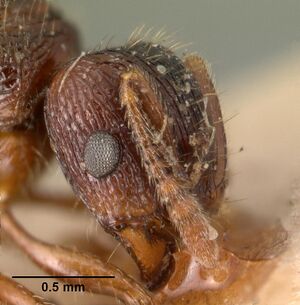 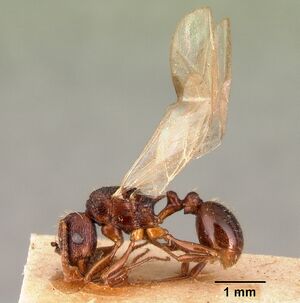 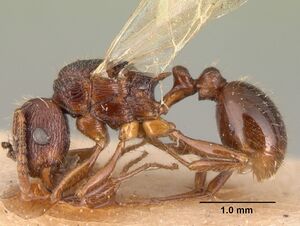  
| |
| Queen (alate/dealate). Specimen code casent0101491. Photographer April Nobile, uploaded by California Academy of Sciences. | Owned by MNHN, Paris, France. |
    
| |
| Paralectotype of Tetramorium steinheili. Queen (alate/dealate). Specimen code casent0101566. Photographer April Nobile, uploaded by California Academy of Sciences. | Owned by MHNG, Geneva, Switzerland. |
    
| |
| Paralectotype of Tetramorium steinheili. Queen (alate/dealate). Specimen code casent0101801. Photographer April Nobile, uploaded by California Academy of Sciences. | Owned by MHNG, Geneva, Switzerland. |
Nomenclature
The following information is derived from Barry Bolton's Online Catalogue of the Ants of the World.
- steinheili. Tetramorium (Xiphomyrmex) steinheili Forel, 1892k: 520 (w.q.) MADAGASCAR. See also: Bolton, 1979: 143; Hita Garcia & Fisher, 2012a: 80.
Unless otherwise noted the text for the remainder of this section is reported from the publication that includes the original description.
Description
Worker
Hita Garcia and Fisher (2012) - HL 0.72 - 0.95 (0.86); HW 0.73 - 0.96 (0.86); SL 0.53 - 0.71 (0.63); EL 0.16 - 0.21 (0.18); PH 0.36 - 0.50 (0.44); PW 0.50 - 0.71 (0.63); WL 0.91 - 1.23 (1.10); PSL 0.20 - 0.40 (0.32); PTL 0.13 - 0.20 (0.17); PTH 0.30 - 0.40 (0.36); PTW 0.20 - 0.31 (0.27); PPL 0.21 - 0.32 (0.27); PPH 0.28 - 0.41 (0.35); PPW 0.27 - 0.40 (0.34); CI 96 - 102 (100); SI 71 - 76 (73); OI 21 - 23 (21); DMI 55 - 60 (57); LMI 38 - 44 (40); PSLI 27 - 44 (37); PeNI 39 - 45 (42); LPeI 42 - 50 (47); DPeI 150 - 168 (157); PpNI 49 - 60 (55); LPpI 64 - 84 (77); DPpI 117 - 138 (127); PPI 119 - 137 (130) (30 measured).
Head usually approximately as long as wide, sometimes longer than wide to wider than long (CI 96 - 102). Anterior clypeal margin medially impressed. Frontal carinae well-developed, usually ending at posterior head margin. Antennal scrobes shallow, narrow, and very weakly developed. Antennal scapes short, not reaching posterior head margin (SI 71 - 76). Eyes comparatively small to moderate (OI 21 - 23). Mesosomal outline in profile flat, weakly to moderately marginate from lateral to dorsal mesosoma, promesonotal suture absent, metanotal groove usually absent, sometimes weakly impressed; mesosoma comparatively stout and high (LMI 38 - 44). Propodeal spines long to very long, variable in shape from thick and stout to thin and fine, usually straight, rarely weakly curving backwards (PSLI 27 - 44); propodeal lobes variable, from broadly triangular and comparatively short to elongate triangular and comparatively long, blunt to acute. Petiolar node in profile squamiform and distinctly anteroposteriorly compressed, approximately 2 to 2.4 times higher than long (LPeI 42 - 50), anterior and posterior faces approximately parallel but anterodorsal margin situated slightly higher than posterodorsal margin, dorsum slightly convex and weakly tapering backwards posteriorly; node in dorsal view 1.5 to 1.7 times wider than long (DPeI 150 - 168). Postpetiole in profile rounded and weakly anteroposteriorly compressed, approximately 1.2 to 1.6 times higher than long (LPpI 64 - 84), in dorsal view between 1.1 to 1.4 times wider than long (DPpI 117 - 138). Postpetiole in profile more voluminous than petiolar node, in dorsal view approximately 1.2 to 1.4 times wider than petiolar node (PPI 119 - 137). Mandibles generally distinctly longitudinally rugose, in some series unsculptured and smooth or weakly sculptured; clypeus with well-developed median longitudinal rugula and one or two rugulae at each side; cephalic dorsum between frontal carinae with six to ten longitudinal rugae, most rugae running unbroken to posterior head margin, few rugae interrupted or with cross-meshes; lateral and ventral head with longitudinal rugae, often with cross-meshes. Ground sculpture generally faint, sometimes moderately developed. Mesosoma laterally with irregular longitudinal rugae; mesosomal dorsum longitudinally rugose, rugae often meandering and with cross-meshes, still distinctly longitudinally arranged. Petiolar node and postpetiole usually with weak sculpture laterally and posteriorly while dorsally unsculptured, both often completely unsculptured, and very rarely with distinctly developed and pronounced ground sculpture. Gaster completely unsculptured, smooth and shining. All dorsal surfaces of body with abundant, long, erect or suberect pilosity. Generally, body of brownish colour, often appendages of lighter brown to dark yellow, sometimes mesosoma of darker brown than remaining body.
Type Material
Hita Garcia and Fisher (2012) - Tetramorium (Xyphomyrmex) steinheili Forel, 1892:520. Lectotype worker [designated here], MADAGASCAR, Forêt d'Andrangoloaka (Musee d'Histoire Naturelle Genève: CASENT0101814) [examined]. Paralectotypes, two workers and two queens with same data as holotype (MHNG: CASENT0101257; CASENT0101258; CASENT0101566); one queen from Imerina (Sikora) (MHNG: CASENT0101801) [examined].
References
- Bolton, B. 1979. The ant tribe Tetramoriini (Hymenoptera: Formicidae). The genus Tetramorium Mayr in the Malagasy region and in the New World. Bull. Br. Mus. (Nat. Hist.) Entomol. 38: 129-181 (page 143, see also)
- Forel, A. 1892l. Nouvelles espèces de Formicides de Madagascar (récoltées par M. Sikora). Première série. Ann. Soc. Entomol. Belg. 36: 516-535 (page 520, worker, queen described)
- Hita Garcia, F. and B. L. Fisher. 2012. The ant genus Tetramorium Mayr (Hymenoptera: Formicidae) in the Malagasy region - taxonomy of the T. bessonii, T. bonibony, T. dysalum, T. marginatum, T. tsingy, and T. weitzeckeri species groups. Zootaxa. 3365: 1-123. PDF
References based on Global Ant Biodiversity Informatics
- Blaimer B. B., S. G. Brady, T. R. Schultz, and B. L. Fisher. 2015. Fucntional and phylogenetic approaches reveal the evolution of diversity in a hyper diverse biota. Ecography 38: 001-012.
- Fisher B. L. 1997. Biogeography and ecology of the ant fauna of Madagascar (Hymenoptera: Formicidae). Journal of Natural History 31: 269-302.
- Fisher B. L. 2003. Formicidae, ants. Pp. 811-819 in: Goodman, S. M.; Benstead, J. P. (eds.) 2003. The natural history of Madagascar. Chicago: University of Chicago Press, xxi + 1709 pp.
- Garcia H. F. and B. L. Fisher. 2012. The ant genus Tetramorium Mayr (Hymenoptera: Formicidae) in the Malagasy regiontaxonomy of the T. bessonii, T. bonibony, T. dysalum, T. marginatum, T. tsingy, and T. weitzeckeri species groups. Zootaxa 3365: 1-123
- Wheeler W. M. 1922. Ants of the American Museum Congo expedition. A contribution to the myrmecology of Africa. IX. A synonymic list of the ants of the Malagasy region. Bulletin of the American Museum of Natural History 45: 1005-1055
